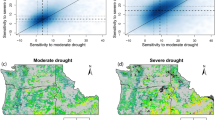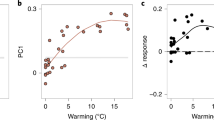Abstract
Drought reduces plant productivity, induces widespread plant mortality and limits the geographic distribution of plant species1,2,3,4,5,6,7. As climates warm and precipitation patterns shift in the future8,9, understanding the distribution of the diversity of plant drought tolerance is central to predicting future ecosystem function and resilience to climate change10,11,12. These questions are especially pressing for the world’s 11,000 grass species13, which dominate a large fraction of the terrestrial biosphere14, yet are poorly characterized with respect to responses to drought. Here, we show that physiological drought tolerance, which varied tenfold among 426 grass species, is well distributed both climatically and phylogenetically, suggesting most native grasslands are likely to contain a high diversity of drought tolerance. Consequently, local species may help maintain ecosystem functioning in response to changing drought regimes without requiring long-distance migrations of grass species. Furthermore, physiologically drought-tolerant species had higher rates of water and carbon dioxide exchange than intolerant species, indicating that severe droughts may generate legacies for ecosystem functioning. In all, our findings suggest that diverse grasslands throughout the globe have the potential to be resilient to drought in the face of climate change through the local expansion of drought-tolerant species.
This is a preview of subscription content, access via your institution
Access options
Subscribe to this journal
Receive 12 print issues and online access
$209.00 per year
only $17.42 per issue
Buy this article
- Purchase on Springer Link
- Instant access to full article PDF
Prices may be subject to local taxes which are calculated during checkout



Similar content being viewed by others
References
Blackman, C. J., Brodribb, T. J. & Jordan, G. J. Leaf hydraulic vulnerability influences species’ bioclimatic limits in a diverse group of woody angiosperms. Oecologia 188, 1113–1123 (2011).
McDowell, N. G. et al. The interdependence of mechanisms underlying climate-driven vegetation mortality. Trends Ecol. Evol. 26, 523–532 (2011).
Sala, O. E., Parton, W. J., Joyce, W. K., L. A., & Lauenroth, Primary production of the central grassland region of the United States. Ecology 69, 40–45 (1988).
Castro, J., Zamora, R., Hodar, J. A. & Gomez, J. M. Seedling establishment of a boreal tree species (Pinus sylvestris) at its southernmost distribution limit: Consequences of being in a marginal Mediterranean habitat. J. Ecol. 92, 266–277 (2004).
Thomas, C. D. et al. Extinction risk from climate change. Nature 427, 145–148 (2004).
Zhao, M. & Running, S. W. Drought-induced reduction in global terrestrial net primary production from 2000 through 2009. Science 329, 940–943 (2010).
Tilman, D. & El Haddi, A. Drought and biodiversity in grasslands. Oecologia 89, 257–264 (1992).
Christensen, J. H. et al. in IPCC Climate Change 2007: The Physical Science Basis (eds Solomon, S. et al.) (Cambridge Univ. Press, 2007).
Romm, J. The next dust bowl. Nature 478, 450–451 (2011).
Isbell, F. et al. High plant diversity is needed to maintain ecosystem services. Nature 477, 199–202 (2011).
Chapin, F. S. et al. Consequences of changing biodiversity. Nature 405, 234–242 (2000).
Walker, B., Kinzig, A. & Langridge, J. Plant attribute diversity, resilience, and ecosystem function: The nature and significance of dominant and minor species. Ecosystems 2, 95–113 (1999).
Grass Phylogeny Working Group II, New grass phylogeny resolves deep evolutionary relationships and discovers C(4) origins. New Phytol. 193, 304–312 (2012).
White, R., Murray, S. & Rohweder, M. Pilot Analysis of Global Ecosystems: Grassland Ecosystems (World Resources Institute, 2000).
Weaver, J. E., Stoddart, L. A. & Noll, W. Response of the prairie to the Great Drought of 1934. Ecology 16, 612–629 (1935).
Weaver, J. E. Prairie Plants and their Environment: A Fifty Year Study in the Midwest (Univ. Nebraska Press, 1968).
McMahon, S. M. et al. Improving assessment and modelling of climate change impacts on global terrestrial biodiversity. Trends Ecol. Evol. 26, 249–259 (2011).
Neilson, R. P. et al. Forecasting regional to global plant migration in response to climate change. Bioscience 55, 749–759 (2005).
Chen, I. C., Hill, J. K., Ohlemuller, R., Roy, D. B. & Thomas, C. D. Rapid range shifts of species associated with high levels of climate warming. Science 333, 1024–1026 (2011).
Reich, P. et al. The evolution of plant functional variation: Traits, spectra, and strategies. Int. J. Plant Sci. 164, S143–S164 (2003).
Wright, I. J. et al. The worldwide leaf economics spectrum. Nature 428, 821–827 (2004).
Craine, J. Resource Strategies of Wild Plants (Princeton Univ. Press, 2009).
Tucker, S. S., Craine, J. M. & Nippert, J. B. Physiological drought tolerance and the structuring of tallgrass assemblages. Ecosphere 2, 48 (2011).
Heckathorn, S. A. & Delucia, E. H. Drought-induced nitrogen retranslocation in perennial C4 grasses of tallgrass prairie. Ecology 75, 1877–1886 (1994).
Staver, A. C., Archibald, S. & Levin, S. A. The global extent and determinants of savanna and forest as alternative biome states. Science 334, 230–232 (2011).
Wardle, P. Vegetation of New Zealand (Cambridge Univ. Press, 1991).
Hacke, U. G., Sperry, J. S. & Pitternman, J. Drought experience and cavitation resistance in six shrubs from the Great Basin, Utah. Basic Appl. Ecol. 1, 31–40 (2000).
Fynn, R., Morris, C., Ward, D. & Kirkman, K. Trait-environment relations for dominant grasses in South African mesic grassland support a general leaf economic model. J. Veg. Sci. 22, 528–540 (2011).
Oyarzabal, M., Paruelo, J. M., Federico, P., Oesterheld, M. & Lauenroth, W. K. Trait differences between grass species along a climatic gradient in South and North America. J. Veg. Sci. 19, 183–U181 (2008).
Godfree, R. et al. Multiscale topoedaphic heterogeneity increases resilience and resistance of a dominant grassland species to extreme drought and climate change. Glob. Change Biol. 17, 943–958 (2011).
Acknowledgements
We thank USDA’s V. Bradley and M. Harrison-Dunn and Landcare Research’s B. Lee for assistance in providing seeds. Helpful comments were provided by L. Sack, P. Adler, T. Joern, A. Elmore, E. Edwards and D. Wedin.
Author information
Authors and Affiliations
Contributions
J.M.C., T.W.O. and J.B.N. conceived the research and carried out the measurements of grasses. E.G.T. and J.M.C. collected plants from Konza. A.M.S. and J.M.C. generated climate envelopes for each species. S.W.K. carried out the phylogenetic analyses. J.M.C. and T.W.O. analysed the data and generated the figures. All authors contributed to the preparation of the manuscript.
Corresponding author
Ethics declarations
Competing interests
The authors declare no competing financial interests.
Supplementary information
Supplementary Information
Supplementary Information (PDF 512 kb)
Rights and permissions
About this article
Cite this article
Craine, J., Ocheltree, T., Nippert, J. et al. Global diversity of drought tolerance and grassland climate-change resilience. Nature Clim Change 3, 63–67 (2013). https://doi.org/10.1038/nclimate1634
Received:
Accepted:
Published:
Issue Date:
DOI: https://doi.org/10.1038/nclimate1634
This article is cited by
-
Climate change filtered out resource-acquisitive plants in a temperate grassland in Inner Mongolia, China
Science China Life Sciences (2024)
-
Growing season temperature and precipitation affect nutrient resorption in herbaceous species through a foliar stoichiometric control strategy
Plant and Soil (2023)
-
Traits that distinguish dominant species across aridity gradients differ from those that respond to soil moisture
Oecologia (2023)
-
Long-term evidence of differential resistance and resilience of grassland ecosystems to extreme climate events
Environmental Monitoring and Assessment (2023)
-
Legacy effects of nitrogen deposition and increased precipitation on plant productivity in a semi-arid grassland
Plant and Soil (2023)



